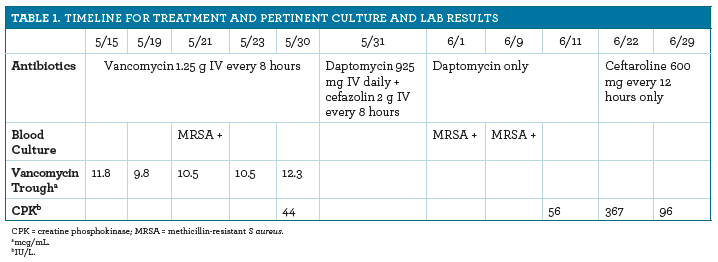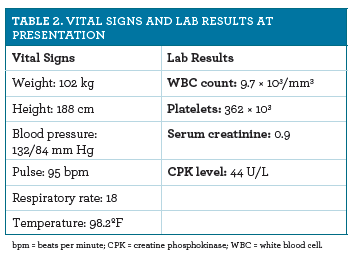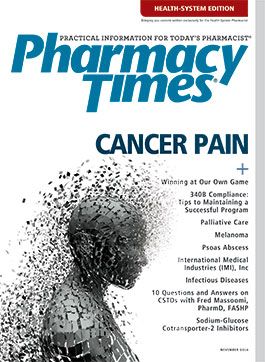Publication
Article
Pharmacy Practice in Focus: Health Systems
Bilateral Psoas Abscess Treated with Multiple Antibiotic Regimens
Abscesses can occur in obscure places in the body, including the psoas muscle.
Abscesses (collections of pus) can occur in obscure places in the body, including the psoas muscle. The psoas (iliopsoas) muscle is part of the hip flexor muscles that connect the 12th thoracic and 5th lumbar vertebral spine. Anatomically, this muscle is very crucial because it is adjacent to some vital organs, including the vertebral spine (along with branching nerves), inferior vena cava, and kidneys. Because of the psoas muscle’s proximity to intraabdominal organs and the circulatory system, infection in the muscle can spread to these sites very quickly.1 Therefore, it is essential that this infection be diagnosed in an efficient and timely manner. However, this is often difficult because the clinical presentation consistently has the usual markers for infection, such as fever and back pain (~30% of cases).2 Other generalized symptoms include nausea, weight loss, and abdominal pain.
Because of the vague clinical presentation of a psoas infection, it can easily be misdiagnosed as diverticulosis, appendicitis, muscle strain, meralgia paresthetica, sciatica, pyelonephritis, septic arthritis of the hip, or abdominal aortic aneurysm.3 Definitive diagnosis is done via computed tomography (CT) scan of the abdomen.
The 2 classifications of psoas abscess are based on the etiology of the infection. Primary psoas abscess occurs due to hematologic spread of bacteria through the lymphatic system. Secondary psoas abscess indicates an alternate source of infection, such as the peritoneum or the spine. Lesions can arise from diverticulosis, Crohn’s disease, or appendicitis.4
The bacteria found in psoas abscesses are determined by the source. In primary psoas abscesses, Staphylococcus aureus is the cause in 95% of cases.5 Our review of the literature did not reveal why this is the case; however, it can be surmised that some type of skin trauma allows introduction of this bacteria into the body. For secondary infection, the type of bacteria depends on the original source of infection. For example, if the primary condition is diverticulitis, the probable pathogens in the psoas abscess would be gram-negative bacilli and/or anaerobes, such as Escherichia coli and Bacterioides fragilis, respectively.6
The first step in treating this infection is incision and drainage; this improves the penetration the subsequent antibiotic. Often, culture results take 5 to 7 days; meanwhile, it is critical that empiric therapy be started. If there are no other sources of infection, the ideal empiric antibiotic regimen is one that adequately covers all S. aureus species, including methicillin-sensitive and methicillin-resistant agents. Because psoas abscesses are classified as severe purulent wound abscesses, intravenous (IV) therapy is initiated with vancomycin or linezolid. When culture results are obtained, reassess the appropriateness of antibiotic therapy and de-escalate as necessary. The duration of antibiotic therapy depends on the extensiveness and severity of the infection, as well as clinical improvement. Although the Infectious Diseases Society of America (IDSA) recommends 4 to 6 weeks of therapy for complicated bacteremia, treatment may be extended depending on clinical response.7

The Case
For an overview of this case, see Table 1. A 44-year-old African American man came to the emergency department with worsening abdominal pain that was sharp and excruciating. The patient’s other symptoms included fever, chills, nausea, vomiting, headache, and some left lower extremity paresthesia. See Table 2 for the patient’s vital signs and lab results at presentation. A CT scan of the abdomen and pelvis revealed diskitis between T12 and L1, as well as fragments and a bilateral psoas abscess measuring, from left to right, 15 mm × 18 mm and 12 mm × 8 mm, respectively. There was some mild impingement involving the S1 nerve root; the exiting nerve root was uninvolved.

Vancomycin was initiated empirically and continued when the patient was admitted. The Interventional Radiology Department aspirated the abscess and sent a sample for culture. Two-dimensional diagnostic imaging was used to ensure that there was no metastatic infection. Cultures revealed methicillin-resistant S. aureus (MRSA) bacteremia sensitive to vancomycin with an MIC of 2 mcg/ml, linezolid, and sulfamethoxazole-trimethoprim. The physician planned to continue IV vancomycin long term, for 12 weeks or longer, depending on the patient’s response. The infectious disease physician felt that oral antibiotics would not be able to penetrate the abscess.
The patient was continued on vancomycin for about 2 weeks until he developed a severe allergic reaction (red man syndrome?). His therapy was switched to daptomycin 925 mg IV daily, with an MIC of 0.5 mcg/ml, in addition to cefazolin 2 g IV every 8 hours for synergy. The patient’s creatine phosphokinase (CPK) level increased over 3 weeks to 367 U/L, and he started experiencing significant nausea. The patient was not taking a statin. More because of the adverse effect than the increase in the CPK level, the physician switched the patient to ceftaroline 600 mg IV every 12 hours. The CPK level began to decrease, and the patient had clinical signs of improvement within 2 weeks. He had a peripherally inserted central catheter line, and continued ceftaroline therapy. The patient was discharged home on oral sulfamethoxazole/trimethoprim and rifampin, with all subsequent cultures negative and the patient’s physical condition was still improving.
Discussion
This case raises the following questions: was the severe reaction to vancomycin a true allergy or red man syndrome, which is easily treatable with diphenhydramine? Would the patient have been better able to tolerate daptomycin if the dose had just been decreased? According to the IDSA guidelines for treating MRSA infections, daptomycin can be given at 8 to 10 mg/kg for complicated MRSA bacteremia. However, considering this is a level B III recommendation (ie, from expert opinion and case reports), the dosing remains open for debate. It will never be truly known if this patient’s psoas abscess could have simply been treated with IV vancomycin. This article was meant to report on an actual patient and highlight differences in practice approaches. We are grateful for the opportunity to be involved in this patient’s care.
Jerry Barbee, Jr, PharmD, BCPS, CPh, is a clinical pharmacist at HCA West Florida Hospital. Glenn Schulman, PharmD, MS, BCPS, BCACP, CGP, is a clinical pharmacist at HCA West Florida Hospital. Alicia Patel is a 2017 PharmD candidate at the University of Florida.
References
- Wong OF, Ho PL, Lam SK. Retrospective review of clinical presentations, microbiology, and outcomes of patients with psoas abscess. Hong Kong Med J. 2013;19(5):416-423. doi: 10.12809/hkmj133793.
- Chern CH, Hu SC, Kao WF, Tsai J, Yen D, Lee CH. Psoas abscess: making an early diagnosis in the ED. Am J Emerg Med. 1997;15(1):83-88.
- Shields D, Robinson P, Crowley TP. Iliopsoas abscess—a review and update on the literature. Int J Surg. 2012;10(9):466-469. doi: 10.1016/j.ijsu.2012.08.016.
- Adelekan MO, Taiwo SS, Onile BA. A review of psoas abscess. Afr J Clin Exp Microbiol. 2004;5(1):55-63.
- Ricci MA, Rose FB, Meyer KK. Pyogenic psoas abscess: worldwide variations in etiology. World J Surg. 1986;10(5);834-843.
- Krobot K, Yin D, Zhang Q, et al. Effect of inappropriate initial empiric antibiotic therapy on outcome of patients with community-acquired intra-abdominal infections requiring surgery. Eur J Clin Microbiol Infect Dis. 2004;23(9):682-687.
- Liu C, Bayer A, Cosgrove SE, et al; Infectious Diseases Society of America. Clinical practice guidelines by the Infectious Diseases Society of America for the treatment of methicillin-resistant Staphylococcus aureus infections in adults and children. Clin Infect Dis. 2011;52(3):e18-e55. doi: 10.1093/cid/ciq146.
- Alobaid AS, Hites M, Lipman J, Taccone FS, Roberts JA. Effect of obesity on the pharmacokinetics of antimicrobials in critically ill patients: a structured review. IntJ Antimicrob Agents. 2016;47(4):259-268. doi: 10.1016/j.ijantimicag.2016.01.009.







